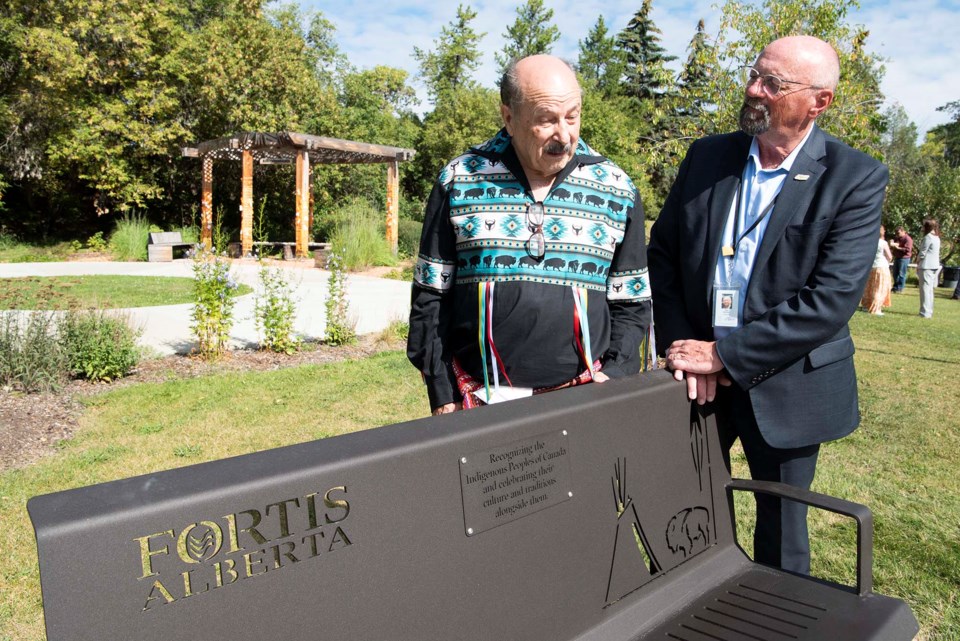St. Albert residents can now sit and think near the city’s Healing Garden on a new bench — a bench one Métis advocate says was placed without proper consultation with the Indigenous community.
About 35 people were at the St. Albert Healing Garden Monday, Aug. 29, to mark the installation of a bench by the garden’s entrance. The bench was donated by FortisAlberta as part of the company’s efforts to address the Truth and Reconciliation Commission’s Calls to Action (specifically No. 92, which applies to businesses).
Built in 2017, the St. Albert Healing Garden was meant to recognize St. Albert’s history with residential schools and advance peace and reconciliation.
FortisAlberta helped sponsor the garden’s creation, noted St. Albert Coun. Ken MacKay, who spoke at Monday’s event. Stan Orlesky, Indigenous relations manager for FortisAlberta, approached the city about the bench earlier this year. Orlesky worked with former Healing Garden committee chair Gwen Crouse to plan Monday’s bench ceremony, which featured demonstrations of Métis fiddling and First Nations drumming and dancing.
Orlesky said the idea for this bench started a few years ago when an employee had FortisAlberta sponsor a bench in Fort Macleod.
The bench itself was designed by Keegan Starlight of the Tsuut’ina Nation and is one of five in Alberta, Orlesky said. (The others are to be installed in Airdrie, Leduc, and Banff.) Cut into its backside are the FortisAlberta logo, a teepee, a feather, and a buffalo. Mounted on it is a plaque which reads, “Recognizing the Indigenous Peoples of Canada and celebrating their traditions and culture alongside them.”
Orlesky said the bench is a way to make reconciliation tangible and meaningful. FortisAlberta is also working with Fort McKay First Nation to create a mandatory training program to teach its staff about Indigenous history, and issued a statement acknowledging how the company’s activities occurred on the traditional lands of the Métis and Indigenous peoples — a statement now posted on plaques in all its offices.
Orlesky said he hopes this bench will make people more aware of the Healing Garden, noting that he had spoken with a man using the bench Monday morning.
“So many times [that man] walked by here never knowing what [that garden] is. But now when you get up from the bench or you go to sit on the bench, you look and you see something is there.”
MacKay said this bench is a part of the community’s ongoing journey of reconciliation with Indigenous peoples.
“The whole idea of a garden is to grow and be nurtured,” he said, and this bench will enhance the Healing Garden.
Consultation?
Michif Cultural Connections knowledge keeper Sharon Morin criticized the placement of the bench at the Healing Garden’s entrance, saying that it had been done without broad consultation with the city’s Indigenous community.
“There was no talking with us at all,” she said, referring to the general St. Albert Métis community, with FortisAlberta only reaching out to her Saturday after she commented on the issue online.
Morin said the bench lacks any stylistic links to St. Albert and has no references to the Métis.
“It is a black spot on a very beautiful space.”
While he acknowledged not everyone is happy with the bench, Orlesky said it had been placed in consultation with Crouse, the Métis Nation of Alberta, and First Nations representatives.
Gary Gairdner, an elder with the St. Albert–Sturgeon County Métis Nation Local #1904, said there are some in the Métis community who felt that the consultation process for this bench was late and should have involved all members of the Healing Garden committee. Still, he commended FortisAlberta for coming up with the idea for the bench.
“It would have been nice if we had been brought in a little bit sooner, but these things happen, and as long as [the action] comes from the heart, it’s OK.”
The Healing Garden and the bench are across the Sturgeon River from St. Albert Place.




